Acoustic Panels – What and Where
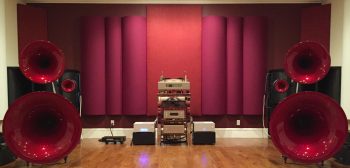
Acoustical treatments involve only two types of acoustic panels: absorbers and diffusers. Absorbers serve to soak up some of the excess reflected sound in a room. Diffusers, on the other hand, help to spread out the reflections in a room.
Combining absorption and diffusion results in clearer, crisper, more satisfying acoustic experiences because it maintains some of the reverberation that is key to our ability to form accurate sound images.
The key to good room acoustics is finding the right mix and placement of acoustic diffusers and absorbers. But just as every space has its own unique acoustic properties, there are likely many different strategies that you could apply to improve their sound.
In this blog, we offer you several scenarios that we hope will help you to understand the principles that should guide you when determining where you should place your sound panels – as well as determine whether, when, and why to use acoustic absorbers rather than diffusers and vice versa.
First Reflection Points
First reflection points are the first points that sound reflects from after leaving your speakers on its way to your ears. They are responsible for the first and worst effects on a room’s acoustics.
Therefore, to develop an acoustical treatment strategy, you should begin by finding where the first reflection points in your room are located.
Locating the first reflection points in your room
In our video, “Acoustic Panels – What & Where,” we demonstrate a simple method that you can use to locate the first reflection points in your room. It involves shooting a nerf gun from one of your speakers and seeing where it hits the wall on the way to your ears. But even if you don’t have a nerf gun, fear not!
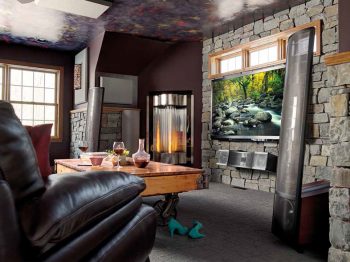 You can also use a method that involves another person, a mirror, and your speakers:
You can also use a method that involves another person, a mirror, and your speakers:
- Ask your assistant to sit facing the speakers at your usual listening/viewing location.
- While your assistant is facing the speakers in front of them, begin sliding a hand-held mirror horizontally along the wall at their ear height and ask them to tell you when they see the center of the speaker reflected in the mirror.
- When your assistant says that they can see the speaker’s center in the mirror, you will have located the first reflection point for that speaker.
- Mark that spot with a tab of painter’s tape.
- Repeat steps 1-4 to locate and mark the other speaker’s first reflection point on the other wall as well.
Note: this will also apply to the ceiling first reflection points if you choose to add acoustic treatments to the ceiling.
Now that you’ve located the first reflection points on your walls, you need to decide whether to treat them with absorbers or diffusers.
Absorption, Diffusion, and Phase
When sound reflects off the walls of your room, it reaches you later because it’s traveling farther than the direct sound. It then destructively combines with the direct sound to interfere with your ears’ ability to accurately hear the direct sound from your speakers. As sound reflections fill a room, they also generate interference amongst themselves, and the result is poor acoustics.
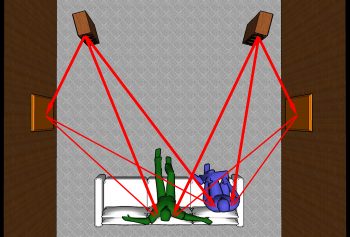
A visual on how sound bounces off from wall panel absorbers.
It’s a lot like sloshing water around in a bathtub. When you introduce energy to the water, that energy propagates in the form of waves, generating peaks, valleys, and dead zones as the waves amplify, diminish, or cancel each other out.
Diffusers serve to spread-out sound energy, thereby reducing the potential for the destructive interferences caused by unimpeded reflections. By spreading out a room’s sound energy, diffusers don’t diminish ambience or pitch perception the way absorbers do, but certain types of diffusion can also create problems themselves.
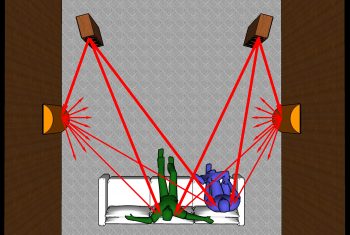
A visual on how sound spreads and bounces off from curved wall diffusers.
Some diffusers, like “quadratic residue” designs, work by distorting the timing or phase relationships within the reflections, and that damages the sound image. In other words, the acoustic experience suffers because we rely on the timing, or phase, of sounds to construct accurate sound images in our minds.
Phase Coherence and Accurate Sound Imaging
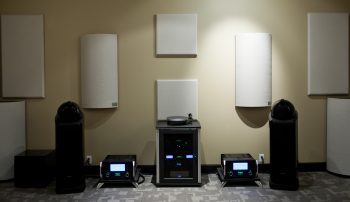 Since our hearing has evolved as a survival tool, our brains are far more sensitive to timing or phase for the purposes of sound location.
Since our hearing has evolved as a survival tool, our brains are far more sensitive to timing or phase for the purposes of sound location.
Think of how quickly you respond when you’re surprised by a sudden, sharp, or loud noise. You instinctively look in the direction from which the sound came as your nervous system primes you either to fight, turn and run, or simply not worry. We may take this for granted, but it really underscores the amazing nature of our brains.
In the same way that having two eyes enables our brain to construct 3-dimensional representations of the world, having two ears also enables us to hear from where a sound is originating in the same 3-dimensional space. This is similar to the highly-refined echo-location system bats use to “see” in the dark.
Even though we might only be able to measure the difference in milliseconds, sound emanating from the same source reaches our ears at slightly different times because of their physical separation on our heads. Our brains then interpret those tiny differences almost instantaneously to determine the location of a sound source. But if the timing of a sound is somehow not what our brains expect it to be, our ability to construct an accurate sound image is thrown off. In a word, things just don’t “sound right” to our ears.
Using phase-distorting diffusers, like quadratic residue types, results in our brain/ear combo being less able to make sense (form an accurate sound image) of the sound it’s hearing. Thus, timing accuracy, or “phase coherence” is essential for both recording and hearing accurate sound imagery.
Check out our blogs and videos, Your Brain On Sound and How Sound Works (In Rooms), for further explanation and illustration of these ideas.
Phase-Coherent Diffusion
Phase-coherent diffusion enables us to better preserve the timing (phase), loudness (amplitude) and tone (harmonics) information in reflections by smoothly spreading-out those reflections and reducing ‘hot spots.’ It also enables us to use less absorption, thereby retaining a level of reverberation that’s agreeable to our ears. RCA Studios in New York, for example, used this method as early as 1941.
Phase-coherent diffusion helps preserve accurate sound imaging and location, and provides us overall crisper, clearer sound as well a wider, stereophonic sense of space.
Treating Walls and Corners
In this scenario, we imagine a rectangular room about 15′ long, 12′ wide, with a standard ceiling height of 8′. To begin, we’ll treat it using 4 Medium Curve Diffusors and 4 Absorber Panels.
Walls
While the conventional wisdom has been to use absorber panels to treat first-reflection points, we believe that our Medium Curve Diffusors offer a more effective option in treating these highly problematic spots. Your stereo field will sound wider, yet the details will be clear and focused because our Curve Diffusors are phase-coherent.
Start by placing Medium Curve Diffusors vertically on the first reflection points. Next, add a vertical one to the back wall, and place one horizontally on the front wall – beneath and parallel to the center speaker below the TV.
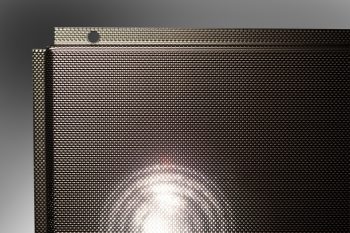 Corners
Corners
Because corners exaggerate sound reflection even further, place a Noise-S.T.O.P. Fabrisorb panel in each corner at the front of the room to reduce side-to-side repeating reflections (also called “flutter echoes”). And finally, place two more fabric-wrapped absorber panels in the corners of the back wall to reduce front-to-back reflections along the length of your room.
These 8 panels combine absorption and diffusion, and they will definitely improve the acoustic quality of the room. Since all rooms are unique, the above solution may work very well for one room, but your room may still require further treatment.
Treating Ceilings
Ceilings, like walls, are large, flat surfaces, and, as such, they should be acoustically treated. For really challenging rooms, you can also incorporate ceiling absorber panels, typically called “clouds.”
Our Ceiling Clouds provide exceptional acoustical control across a wide range of frequencies while reducing echo and reverberation. They’re lightweight, easy to install, and suspended on ceiling-mounted cables using corkscrew-type hangers.
For best effect, place two clouds on the ceiling at the first reflection points, and two above your seating area.
For drop-in ceiling grids, our Silk Metal Acoustic Panels provide superior echo and reverberation reduction with an excellent NRC rating of 0.80. These state-of-the-art panels incorporate cutting-edge micro-perforation technology at a great price.
Adding more panels
You can also add two more Medium Curve Diffusors on each side wall at a right-angle to the seating position. This will serve to eliminate the most annoying “flutter echoes” from the viewer/listener’s perspective.
Conclusion
You don’t need to treat every square foot of your room to have great acoustics. A strategic combination of absorption and diffusion targeting the problem spots in your room – the first reflection points, corners, ceilings, etc. – can make a bad-sounding room into a fantastic-sounding one.
Our Acoustical Surfaces sales staff is always happy to talk about our products with you. For more information and a wealth of resources, please visit https://www.acousticalsurfaces.com/.



